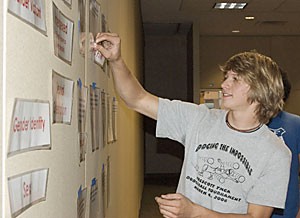Gender is a social construction and the identification as one particular gender is a continuum, rather than an “”either/or”” situation, a UA official said at a Transgender Awareness Week event yesterday.
“”(Gender) is created, it’s basically made up,”” said Brian Shimamoto, interim director of Asian Pacific American Student Affairs, who conducted the workshop “”Gender Identity,”” a program put on by SafeZone and Residence Life to educate people about the transgender community.
“”It’s been passed down from generation to generation to generation,”” Shimamoto said, adding that race is also a social construct because less than 1 percent of human DNA varies between people.
The one thing Shimamoto said he hoped attendees took away from the program was that gender identity and sexual orientation are not the same thing.
He stressed that gender identity is who a person is, or how he or she identifies himself or herself, while sexual orientation is about whom one loves or has sex with.
“”We have a tendency to think about gender as a dichotomy,”” Shimamoto said. “”As either/or, male or female. It might not be a dichotomy. It might be a continuum.””
In raising their children, parents tend to have them do chores that seem appropriate to their genders, he said.
“”My sister never got asked to mow the lawn,”” Shimamoto said.
One of the activities at the workshop asked participants to match terms with definitions.
One of the terms was “”transgender,”” which “”describes those who have gender identities, expressions or behaviors not traditionally associated with their birth sex,”” according to a Diversity Initiatives handout.
While going over tips on how to interact with transgender people, the topic of transitioning from one sex to another was touched upon.
Alison Davison, program coordinator for the Alexander John Goodrum Transgender Mental Health Advocacy Project, said the medical community previously required that a person who desires to change sexes through surgery live as his or her preferred gender full-time for a year or two.
But the Benjamin Standards, a guide for doctors, no longer require it, she said.
“”It is a profound choice,”” she said, as it is difficult to change one’s mind at a certain point.
Michael Woodward, program coordinator for the Southern Arizona Gender Alliance, transitioned from female to male and said the first couple of months of hormone therapy were odd.
It was somewhat like going through puberty again, he said, adding that he was 36 years old at the time.
Shimamoto cautioned everyone at the workshop to be careful about labeling someone who does not conform to “”normal”” ideas of sexuality as transgender.
Additionally, never use the pronoun “”it”” when referring to a person whose gender is not clear, he said. It is best to ask the person how he or she wishes to be identified.









